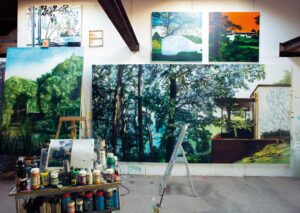How do you set yourself up as an artist? And what does it look like where the works are created? Each issue of Fagbladet Biledkunstneren presents an artist workshop:
The artist's workshop: Eamon O'Kane (b. 1974), The visual artist #3, 2023
It has always been my dream to have my studio in the same place as my home, preferably in a place with several buildings. In August 2009, my wife and I took over a disused horticulture near Odense with an attached home, packing room, boiler room, staff room etc. Gartneriet's 6.000 m2 greenhouses were in use until the day we took it over. The process of adapting this small industrial complex into an artist's workshop began immediately, because I needed a place to store all my things and continue working on artworks for upcoming exhibitions.
Although people thought we were crazy, the place was remarkably compatible with my workshop needs: spacious buildings with good access to each other and of different sizes and heights. The logic of operating the horticulture fit the logic of an art production, and many of the used tools and materials were given new life: plastic for packaging artworks, plant pots for mixing paint, extension cords and lighting were reused, the metal transport carts became movable walls, and a huge stainless steel table was used to create a smaller printing workshop. All decisions followed a certain logic and it felt as if the buildings were almost destined for their new purpose. There were remnants of the gardeners' work everywhere – concrete drainage pipes, huge rolling tables made of plastic and aluminium, ceilings crammed with obsolete and broken material, thirty years' worth of accounts in thick binders, kilometers of plastic pipes and all sorts of large and small machines. I have used many of the things from the site in my artworks, so in that way, it has had a direct influence on my work. For example, I have converted the lamps into light boxes for displaying photos, trees from the ground have been painted and used in installations, and strange disks from a water purification machine have been used for prints and casts.
The best building was the old boiler room, which housed a huge boiler tank and the district heating system. A local gardener luckily took over all the equipment and thus I got an isolated 80 m2 painting workshop with 6 meter ceilings. However, there is no heating in either this or the other workshops, so in winter it's on with the adult flight suit - or work on smaller works in my office in the house.
I have always photographed a lot and made videos, so I started documenting the development of the place from day one. At the same time as we gradually renovated the buildings, the greenhouses quickly fell into disrepair. Trees grew up everywhere and animals moved in. After 10 years we decided they had to go completely because of the danger of crashing. Now there is grass, trees, wild flowers, deer and hares where there used to be industry. The 'project' resulted in a photo book published in 2019, "And Time Begins Again". There is still a lot of work to be done with the buildings before they are completely ideal, but that will come.